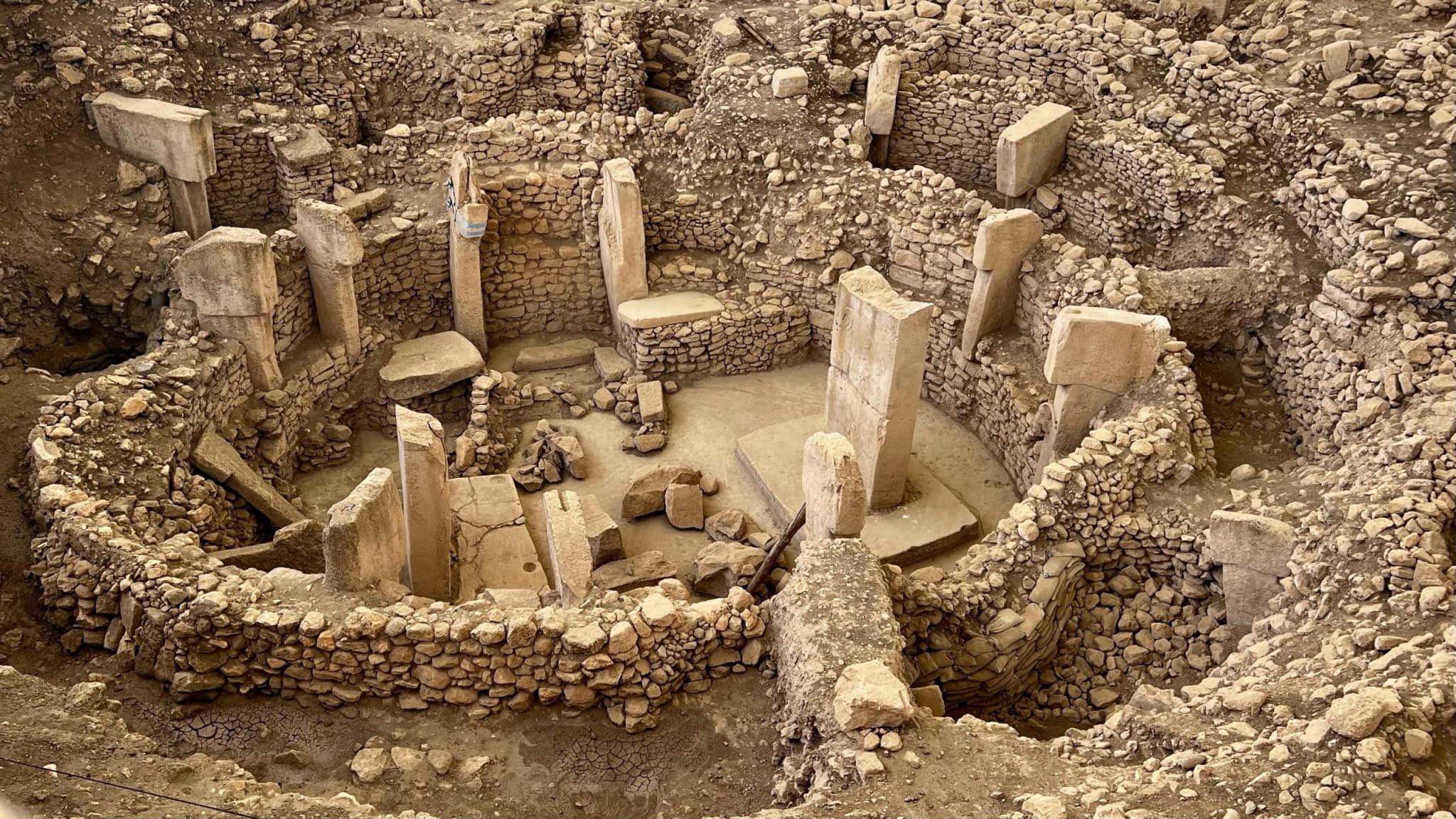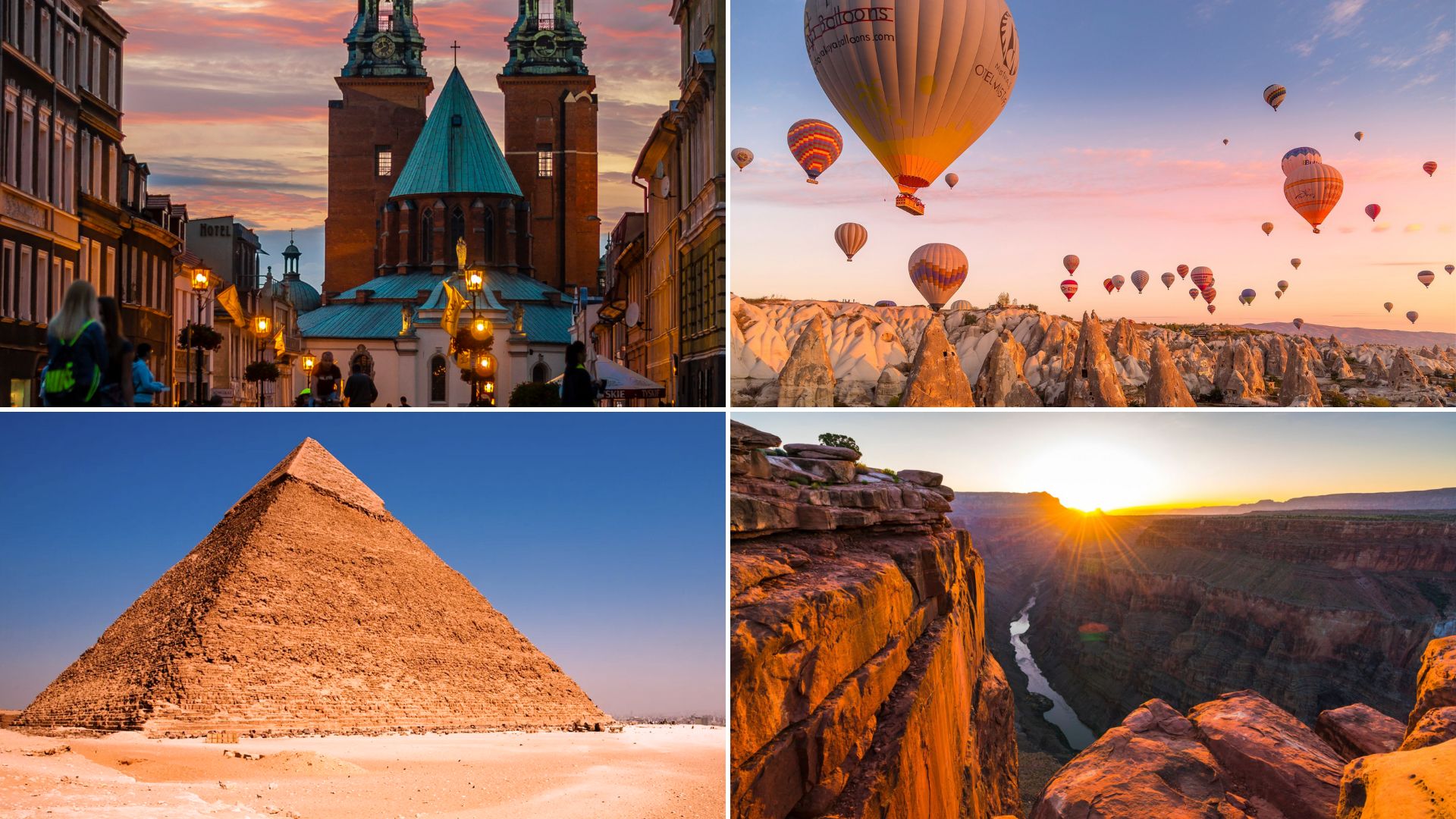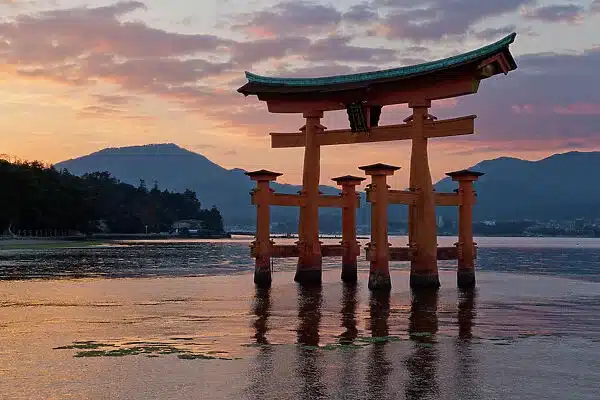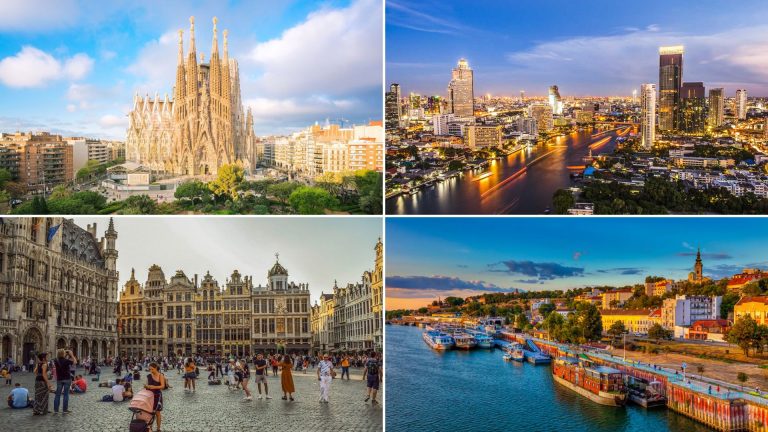Planning a Trip to 40 Glorious Historical Sites That Start with G? Ask Us Anything!
Go on an exciting trip through history as we show you 40 amazing historical sites that start with the letter ‘G.’
From old wonders that have lasted for a long time to building masterpieces that still impress people today, this guide takes you worldwide to see humanity’s most remarkable achievements.
Experience the greatness of the Great Pyramids of Giza, be amazed by the impressive Great Wall of China, and get lost in the beautiful art of the Guggenheim Museum Bilbao.
Get ready to be stunned by natural wonders like the Grand Canyon and the Galapagos Islands, where nature has created landscapes of unmatched beauty.
Join us as we explore these glorious sites, each with a unique story and lasting legacy.
1. Giza Pyramids
The Giza Pyramids are one of the world’s most famous and iconic ancient structures. Located in Giza, Egypt, these massive stone pyramids were built as tombs for the Egyptian Pharaohs around 2500 BC. The three largest are the Great Pyramid of Khufu, the Pyramid of Khafre, and Menkaure.
- Location: Giza, Egypt
- Best Time to Visit: October to April for cooler temperatures
- Interesting Facts: The Great Pyramid was the tallest man-made structure for over 3,800 years until the Eiffel Tower. Each stone weighs 2.5 tons on average, showcasing the incredible engineering skills of the time.
2. Great Wall of China
The Great Wall of China is an ancient fortification stretching across the northern borders of China over mountains and deserts for over 13,000 miles (21,000 km). Construction began in the 3rd century BC to protect against invasions.
- Location: Northern borders of China
- Best Time to Visit: Spring and Fall for mild weather
- Interesting Facts: The wall is visible from space and required hundreds of thousands of workers to build it using basic tools for over 2,000 years, making it one of humanity’s most impressive feats.
3. Guggenheim Museum Bilbao
The Guggenheim Museum Bilbao is a modern art museum designed by architect Frank Gehry. Its striking titanium facade resembles a deconstructed ship and is considered an architectural masterpiece.
- Location: Bilbao, Basque Country, Spain
- Best Time to Visit: Spring and Fall
- Interesting Facts: Advanced computer modeling allowed Gehry to design the museum’s unique curved shapes and materials. It opened in 1997 and kicked off the iconic museum architecture trend.
4. Grand Canyon
The Grand Canyon is a breathtaking natural wonder carved by the Colorado River over millions of years in Arizona, USA. It stretches 277 river miles (446 km) long, up to 18 miles (29 km) wide, and over a mile (1.6 km) deep.
- Location: Arizona, United States
- Best Time to Visit: Spring and Fall for moderate temperatures
- Interesting Facts: Considered one of the Seven Natural Wonders, the exposed rock layers represent over 2 billion years of geological history. It attracts over 6 million visitors annually for hiking, rafting, and sightseeing.
5. Galapagos Islands
The Galapagos Islands are a volcanic archipelago off Ecuador’s coast. They are famous for unique plant and animal species, such as the giant tortoise and marine iguana, that inspired Darwin’s theory of evolution.
- Location: the Pacific Ocean, 600 miles (966 km) off Ecuador
- Best Time to Visit: December to May for warm weather
- Interesting Facts: Due to isolation, species evolved distinctively here, making it a living museum of evolution. Strict conservation efforts protect this fragile ecosystem’s biodiversity.
6. Göreme National Park
Göreme National Park features a unique landscape of honeycombed rock formations, tall “fairy chimneys,” and ancient cave dwellings carved into the soft volcanic rock of Cappadocia.
- Location: Cappadocia region, Central Anatolia, Turkey
- Best Time to Visit: April to June and September to November
- Interesting Facts: The park contains one of the world’s largest rock-cut churches, chapels, and underground cities dating to the 4th century, showcasing the region’s cultural heritage.
7. Great Mosque of Djenné
The Great Mosque of Djenné is one of the most impressive mud-brick buildings in the world. It features towering walls, intricate carvings, and a vast plaza in the Sudano-Sahelian style.
- Location: Djenné, Mali
- Best Time to Visit: November to March (dry season)
- Interesting Facts: Built in the 13th century, the mosque requires constant re-plastering with mud using traditional methods due to its fragile construction material.
8. Gelati Monastery
The Gelati Monastery is a medieval monastic complex and a UNESCO site in Georgia. It features exquisite stone carvings, mosaics, frescoes, and an ensemble of churches and academies.
- Location: Near Kutaisi, Imereti region, Georgia
- Best Time to Visit: May to October
- Interesting Facts: It was an important center of philosophy, theology, and education in the 12th century. The main cathedral displays fine examples of Byzantine architecture and Georgian medieval mosaics.
9. Giza Necropolis
The Giza Necropolis is an ancient burial ground near Cairo. It is most famous for the iconic Giza Pyramids but contains numerous other pyramids, the Sphinx, temples, and tombs.
- Location: Giza Plateau, near Cairo, Egypt
- Best Time to Visit: October to April
- Interesting Facts: It was the burial site for rulers and elites of the Old Kingdom, containing some of the oldest and largest monuments on Earth, such as the last remaining Ancient Wonder.
10. Garni Temple
The Garni Temple is a major cultural landmark dating from the 1st century AD. It is a Greco-Roman pagan temple with an imposing colonnade and an Ionic architectural style.
- Location: Garni Village, Kotayk Province, Armenia
- Best Time to Visit: May to October
- Interesting Facts: A unique example of a Hellenistic temple in the Caucasus region that remarkably survived as a pagan shrine in a predominantly Christian area by the 4th century.
11. Golestan Palace
The Golestan Palace is a magnificent royal residence and UNESCO World Heritage Site in Tehran. It features a lavish complex of gardens, marble buildings, and ornate halls adorned with intricate tilework, frescoes, and mirrored interiors, exemplifying the finest Persian art and architecture.
- Location: Central Tehran, Iran
- Best Time to Visit: Spring (March-May) and Fall (September-November)
- Interesting Facts: The oldest parts of the palace date back to the 16th century, though much of the current structure was built during the 19th century Qajar era. It served as the official residence of the Persian monarchs until the 1920s.
12. Great Stupa at Sanchi
The Great Stupa at Sanchi is a monumental Buddhist structure and one of the oldest stone structures in India. This beautifully carved stupa features intricate reliefs depicting scenes from the life of Buddha and various mythological events.
- Location: Sanchi Town, Madhya Pradesh, India
- Best Time to Visit: October to March for pleasant weather
- Interesting Facts: The Great Stupa dates back to the 3rd century BCE and was originally commissioned by Emperor Ashoka. Over the centuries, various dynasties added gateways and embellishments, making it an architectural masterpiece of multiple eras.
13. Giant’s Causeway
The Giant’s Causeway is a remarkable geological formation along Northern Ireland’s coastline. It features thousands of interlocking basalt columns created by ancient volcanic activity.
- Location: Causeway Coast, County Antrim, Northern Ireland
- Best Time to Visit: Spring and Summer for mild weather
- Interesting Facts: The unique hexagonal columns were formed 50-60 million years ago during intense volcanic eruptions. Their striking geometric patterns have inspired legends of a giant’s road across the sea.
14. Golden Temple
The Golden Temple, officially known as Sri Harmandir Sahib, is the most sacred shrine and spiritual center for the Sikh faith. This stunning temple features a mesmerizing golden structure with ornate details, surrounded by the holy Amrit Sarovar (pool of nectar).
- Location: Amritsar, Punjab, India
- Best Time to Visit: November to March for ideal weather
- Interesting Facts: The four entrances symbolize openness and welcome to people of all faiths and backgrounds. The lower marble floors and walkways allow devotees to circle the temple while submerging in the holy waters.
15. Gwalia Ghost Town
The Gwalia Ghost Town is a remarkably well-preserved abandoned mining town that offers a glimpse into the life and hardships of early 20th-century gold miners in Western Australia’s Goldfields region.
- Location: Near Leonora, Western Australia
- Best Time to Visit: April to October for milder temperatures
- Interesting Facts: At its peak in the early 1900s, Gwalia had over 1,000 residents working at the Sons of Gwalia gold mine. The town was abandoned in 1963 but left intact, with original buildings, machinery, and household items remaining.
16. Gyeongbokgung Palace
The Gyeongbokgung Palace is an iconic royal palace from the Joseon Dynasty and one of Seoul’s most well-preserved architectural masterpieces. Its grand buildings, pavilions, and gates showcase traditional Korean architecture.
- Location: Central Seoul, South Korea
- Best Time to Visit: Spring (April) and Fall (October) for the changing foliage
- Interesting Facts: Originally built in 1395, the palace was destroyed by fire during the Japanese invasion in the 1590s. It underwent several reconstructions and expansions, with the current structures dating back to the 19th century.
17. Gallo-Roman Ruins of St. Romain-en-Gal
The Gallo-Roman Ruins of St. Romain-en-Gal is a remarkably well-preserved archaeological site showcasing the remains of a wealthy Gallic city dating back to the 1st century BCE, during the Roman occupation.
- Location: St. Romain-en-Gal, Rhône-Alpes region, France
- Best Time to Visit: April to October for comfortable weather
- Interesting Facts: The site includes impressive ruins of public buildings, homes, mosaics, and an odeon (small theater). It provides insights into the assimilation of Roman culture by the Gauls in this region.
18. Gila Cliff Dwellings
The Gila Cliff Dwellings are a remarkable example of ancient Native American architecture. They consist of cave dwellings built into the cliffs by the Mogollon people between the 13th and 14th centuries.
- Location: Gila Wilderness, New Mexico, USA
- Best Time to Visit: Spring and Fall for mild temperatures
- Interesting Facts: These dwellings were built high up in the cliffs, likely for defensive purposes. The structures were constructed with skillfully placed wooden beams and stone masonry, with some multi-story dwellings housing over 40 rooms.
19. Great Mosque of Grenada
The Great Mosque of Grenada, also known as the Mosque-Cathedral of Córdoba, is a remarkable example of Islamic architecture and a UNESCO World Heritage Site. This iconic structure was originally a mosque built in the 8th century and later converted into a Catholic cathedral in the 13th century.
- Location: Córdoba, Andalusia, Spain
- Best Time to Visit: Spring and Fall for comfortable temperatures
- Interesting Facts: The mosque’s interior features a stunning hypostyle hall with over 850 columns connected by distinctive arched striped patterns. Its unique blend of Islamic and Christian architectural styles represents the region’s multicultural history.
20. Göbekli Tepe

Göbekli Tepe is an ancient archaeological site and one of the oldest known temple complexes in the world, predating even the great pyramids of Egypt. Its striking circular structures, carved with intricate animal reliefs, were built by hunter-gatherers over 11,000 years ago.
- Location: Southeastern Anatolia, Turkey
- Best Time to Visit: Spring and Fall for mild weather
- Interesting Facts: The site’s monumental carved pillars and advanced construction techniques challenge our understanding of prehistoric societies. Göbekli Tepe is considered a crucial archaeological discovery, providing insights into the origins of civilization itself.
21. Gniezno Cathedral
The Gniezno Cathedral, also known as the Cathedral of the Assumption of the Blessed Virgin Mary, is a magnificent Gothic and Romanesque cathedral in central Poland. It served as the coronation site for Polish monarchs and is considered one of the country’s most important churches.
- Location: Gniezno, Greater Poland Voivodeship, Poland
- Best Time to Visit: Spring and Summer for milder weather
- Interesting Facts: The cathedral contains the renowned Gniezno Doors, intricately decorated with Romanesque bronze sculptures depicting biblical scenes. It also houses the purported relics of St. Adalbert, the patron saint of Poland.
22. Gamla Stan
Gamla Stan is the charming and remarkably well-preserved old town of Stockholm, dating back to the 13th century. Its winding cobblestone streets, colorfully painted historical buildings, and medieval architecture create a captivating atmosphere.
- Location: Central Stockholm, Sweden
- Best Time to Visit: May to September for pleasant weather
- Interesting Facts: Gamla Stan is one of the best-preserved medieval city centers in Europe. Key attractions include the Storkyrkan Cathedral, the Nobel Prize Museum, and the Royal Palace, the official residence of the Swedish monarchy.
23. Geysir Hot Spring Area
The Geysir Hot Spring Area is a geothermal wonderland in Iceland, famous for its active geysers. The iconic Strokkur geyser erupts every few minutes, shooting hot water up to 100 feet (30 meters) into the air.
- Location: Haukadalur Valley, southwestern Iceland
- Best Time to Visit: Summer (June-August) for long daylight hours
- Interesting Facts: The word “geyser” originates from the Icelandic “Geysir,” the name of the oldest known geyser in the area, which has been dormant since the 1960s. The geysers are powered by intense geothermal activity and underground reservoirs of boiling water.
24. Görlitz Old Town
The Görlitz Old Town is a remarkably well-preserved medieval town in eastern Germany, renowned for its stunning architectural heritage and charming atmosphere. Its historic city center features countless Gothic, Renaissance, and Baroque buildings, churches, and squares.
- Location: Görlitz, Saxony, Germany (near the Polish border)
- Best Time to Visit: Spring and Fall for mild weather
- Interesting Facts: Görlitz’s historic center has been a backdrop for numerous films due to its remarkably intact and picturesque cityscape. It has been called the “Görliwood” of Germany, hosting productions like Inglourious Basterds and The Grand Budapest Hotel.
25. Great Baths of Mohenjo-Daro
The Great Baths of Mohenjo-daro are archaeological sites featuring the ancient Indus Valley Civilization’s remarkably advanced water and sanitation systems. These massive public baths showcase this ancient culture’s engineering prowess and urban planning.
- Location: Sindh Province, Pakistan
- Best Time to Visit: November to March for cooler weather
- Interesting Facts: The Great Baths date back to around 2500 BCE and feature an intricate system of bathing pools, brick chambers, and drainage systems. They provide evidence of sophisticated hydraulic engineering and advanced urban planning in this ancient civilization.
26. Gobustan Rock Art Cultural Landscape
The Gobustan Rock Art Cultural Landscape is a UNESCO World Heritage Site in Azerbaijan, renowned for its extensive rock carvings and petroglyphs dating back to the Upper Paleolithic era (around 10,000 BC).
- Location: Gobustan, near Baku, Azerbaijan
- Best Time to Visit: Spring (April-May) and Fall (September-October) for mild weather
- Interesting Facts: The site features over 6,000 rock carvings depicting scenes of hunting, dancing, and ancient lifestyles. These petroglyphs provide valuable insights into the lives and beliefs of prehistoric humans in the region.
27. Great Mosque of Ghardaïa
The Great Mosque of Ghardaïa is a stunning example of traditional Mozabite architecture and a significant cultural landmark in the M’zab Valley of northern Algeria. Its towering pyramidal minaret and intricately decorated interiors showcase the unique architectural style of the region.
- Location: Ghardaïa, M’zab Valley, Algeria
- Best Time to Visit: Spring and Fall for pleasant temperatures
- Interesting Facts: The mosque was built in the 14th century and features a blend of Islamic, Berber, and sub-Saharan influences in its design. Its iconic minaret is one of the tallest mudbrick minarets in the world, rising 125 feet (38 meters) high.
28. Great Meteoron Monastery
The Great Meteoron Monastery is a remarkable Eastern Orthodox monastery built atop a towering sandstone rock pillar in central Greece. Part of the larger Meteora monastic complex, it is one of the world’s most striking and vertically imposing monasteries.
- Location: Thessaly region, central Greece
- Best Time to Visit: Spring and Fall for mild weather
- Interesting Facts: The monastery was built in the 14th century and was only accessible by climbing removable ladders or being hoisted up in a net. Its precarious location atop a 1,300-foot (400-meter) rock pillar was chosen for defensive purposes.
29. Geghard Monastery
The Geghard Monastery is a medieval Armenian monastery carved from the adjacent mountain rock, creating a unique and visually stunning architectural complex.
- Location: Kotayk Province, Armenia
- Best Time to Visit: Spring (April-June) and Fall (September-November) for pleasant weather
- Interesting Facts: The monastery dates back to the 4th century, with its main cathedral carved directly into the mountain during the 13th century. The complex features churches, tombs, and living quarters seamlessly hewn into the rock, showcasing Armenian architects’ exceptional stonework and craftsmanship. The monastery’s name, Geghard, means “spear” in Armenian, referring to the legendary spear used to crucify Jesus, allegedly brought to the monastery in the 4th century.
30. Great Mosque of Córdoba
The Great Mosque of Córdoba (Mezquita) is an immense mosque dating back to the 8th century and one of the oldest structures still standing from the Moorish Islamic rule of Spain. Its sheer scale and arched design showcase outstanding Islamic architecture.
- Location: Córdoba, Andalusia, Spain
- Best Time to Visit: March to May or September to November for milder temperatures
- Interesting Facts: Construction began in 784 CE but underwent numerous expansions over two centuries. The mosque features a roofed prayer hall area with over 850 jasper, marble, granite, and porphyry columns. The archetypal Moorish arches and alternating red and white voussoirs create a visually striking interior. After the Reconquista, a Renaissance-style cathedral was inserted into the mosque’s center.
31. Guanajuato City
Guanajuato City is a well-preserved colonial-era city in central Mexico, known for its picturesque alleys, plazas, and underground tunnels. It showcases a rich blend of Spanish and indigenous architectural styles.
- Location: Guanajuato State, Mexico
- Best Time to Visit: Spring (March-May) and Fall (September-November) for mild weather
- Interesting Facts: The city is renowned for its unique underground street system, built to divert rivers and provide a network of tunnels and passageways. Its historic center, colorful buildings and colonial churches, is a UNESCO World Heritage Site.
32. Great Mosque of Samarra
The Great Mosque of Samarra is a 9th-century mosque in Samarra, Iraq. With its iconic spiral minaret and vast prayer hall, it is one of the most significant remnants of the Abbasid Caliphate’s architectural prowess.
- Location: Samarra, Iraq
- Best Time to Visit: Spring (March-May) and Fall (September-November) for milder weather
- Interesting Facts: Construction began in 848 CE under the Abbasid caliph Al-Mutawakkil. The mosque complex covers an area of over 400,000 square meters. Its most distinctive feature is the spiral Great Minaret, which rises 52 meters and has a spiral ramp ascending around the exterior. The prayer hall measures 240 x 156 meters, making it one of the largest mosques ever built at the time.
33. Great Zimbabwe Ruins
The Great Zimbabwe Ruins are the largest ancient stone ruins in sub-Saharan Africa, dating back to the 11th century. These impressive remains of an ancient city showcase the Shona people’s advanced architecture and engineering skills.
- Location: Masvingo Province, Zimbabwe
- Best Time to Visit: May to September for dry weather
- Interesting Facts: The ruins consist of massive circular stone walls, towers, and intricate stone masonry constructed without mortar. They are a testament to the wealth and sophisticated society that once flourished in this region.
34. Great Ziggurat of Ur
The Great Ziggurat of Ur is an ancient stepped pyramid and one of the best-preserved ziggurats in the world. It was built around 2100 BCE in the ancient Sumerian city-state of Ur, now in modern-day Iraq.
- Location: Near Nasiriyah, Dhi Qar Governorate, Iraq
- Best Time to Visit: Spring and Fall for mild temperatures
- Interesting Facts: The ziggurat was constructed with mud bricks and an outer layer of burned bricks to give it a striking red color. It originally consisted of three levels and was likely dedicated to the moon god Nanna.
35. Grand Bazaar
The Grand Bazaar is one of the world’s largest and oldest covered markets. It is a labyrinth of streets, shops, and stalls selling various goods, from spices and textiles to ceramics and jewelry.
- Location: Fatih District, Istanbul, Turkey
- Best Time to Visit: Spring and Fall for comfortable temperatures
- Interesting Facts: The bazaar has operated since the 15th century and has over 4,000 shops and stalls. It attracts over 250,000 visitors daily, making it one of the world’s most visited tourist attractions.
36. Giant Wild Goose Pagoda
The Giant Wild Goose Pagoda is a magnificent Buddhist pagoda and one of the most iconic landmarks in Xi’an, China. This towering brick pagoda dates back to the 7th century and stands over 210 feet (64 meters) tall.
- Location: Xi’an, Shaanxi Province, China
- Best Time to Visit: Spring and Fall for pleasant weather
- Interesting Facts: The pagoda was built to house the Buddhist scriptures and relics from India by the famous monk Xuanzang. Its unique shape and sloping design were engineered to withstand earthquakes and strong winds.
37. Gdansk Old Town
Gdansk Old Town is a beautifully preserved historic district in Gdansk, Poland. Its charming streets, grand churches, and colorful buildings blend Gothic, Renaissance, and Baroque architectural styles.
- Location: Gdansk, Pomerania Region, Poland
- Best Time to Visit: May to September for mild weather
- Interesting Facts: Many buildings were meticulously reconstructed after World War II using original materials and historic plans. The impressive St. Mary’s Church and the iconic Gdansk Town Hall are key attractions.
38. Grotte di Castellana Caves
The Grotte di Castellana Caves are a vast underground cave system featuring stunning stalactites, stalagmites, and cave formations carved out by ancient underground rivers over millions of years.
- Location: Castellana Grotte, Apulia region, Italy
- Best Time to Visit: Spring and Fall for comfortable temperatures
- Interesting Facts: This extensive cave system extends for over 3 kilometers (1.9 miles) and reaches depths of up to 122 meters (400 feet). It features a remarkable variety of cave formations, including the giant “Grave” stalagmite, one of the tallest in the world.
39. Great Mosque of Gaza
The Great Mosque of Gaza, also known as the Great Omari Mosque, is a historic mosque dating back to the 7th century. It is one of the region’s oldest and most significant Islamic structures.
- Location: Gaza City, Gaza Strip, Palestine
- Best Time to Visit: Spring and Fall for mild weather
- Interesting Facts: The mosque was built in 635 CE and has undergone numerous renovations. Its current structure dates back to the 12th century and features a striking minaret and intricately decorated interiors with marble columns and mosaic tilework.
40. Gordes Village
The Gordes Village is a picturesque hilltop village in the Luberon region of Provence, France. It is renowned for its stunning architecture, charming stone houses, and breathtaking views of the surrounding Provençal countryside.
- Location: Vaucluse department, Provence-Alpes-Côte d’Azur, France
- Best Time to Visit: Spring and Fall for pleasant weather
- Interesting Facts: Gordes has been designated as one of the “Plus Beaux Villages de France” (Most Beautiful Villages of France) and has attracted artists and writers for centuries, inspired by its rustic beauty and scenic landscapes.
Final Thoughts
As we finish our fascinating journey through the 40 glorious historical sites starting with ‘G,’ we deeply appreciate the rich human creativity and nature’s boundless imagination.
From ancient civilizations to modern marvels, these sites have stood as beacons of human achievement, reminding us of our shared heritage and the enduring power of perseverance.
Whether you seek inspiration from architectural wonders, spiritual growth from sacred places, or a deeper connection with the natural world, these sites offer a gateway to discovery and personal development.
Let this exploration ignite a lifelong passion for understanding our past and preserving these treasures for future generations.














































